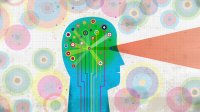Using Cognitive Science to Boost Learning
Especially now, after a difficult year, strategies rooted in the science of learning can help middle and high school students more effectively retain what they’re learning.
Your content has been saved!
Go to My Saved Content.Many schools will reopen this fall with significant uncertainty around student academic performance. Some students will have significant unfinished learning—content they normally would have mastered at their age but did not because of inefficiencies in remote and hybrid school environments and the greater social and emotional trauma of the pandemic.
Faced with this challenge of unfinished learning, many schools will be tempted to look to remediation strategies to catch kids up. In The Acceleration Imperative, a report released this spring by the Fordham Institute, researchers suggest that the focus should be on accelerated learning rather than remediation.
To do this, schools must devote the bulk of instructional time to challenging, grade-level content. Teachers will need to build small group work, classroom stations, and similar differentiated supports into their lessons to target specific gaps in student skills. For many, individualized tutoring will be necessary. However, the learning experiences within day-to-day class time remain the single most efficient and important opportunity to meet our students’ academic needs.
It won’t be easy. The challenge of unfinished learning and the need to accelerate demand efficiency in our instruction.
Fortunately, there are existing models to turn to. Over the last 20 years, the field of cognitive science has made enormous gains in understanding how students learn. Dubbed the science of learning, this field poses real promise for classroom practice and offers strategies for improved questioning, modeling, and feedback.
This spring, teacher leadership teams at two Bronx high schools studied key ideas within cognitive science as they made plans for the fall. Those ideas, which are rooted in strengthening memory and posing questions, will be explicitly folded into instruction.
Retrieval Practice
At New York City’s High School of Violin and Dance—a comprehensive high school in the Bronx—a core group of teacher leaders, administrators, and coaches spent the spring studying research on retrieval practice.
This concept focuses not on how we get information into students’ brains but on how students get information out of their brains. Cognitive scientists have discovered that when students struggle to bring information to mind (as with quizzes), that act of retrieval actually boosts learning itself. In other words, memory is strengthened when students attempt to retrieve information—especially when a little forgetting has taken place to the degree that students struggle to recall.
In its weekly meetings, the team reviewed resources from the Learning Agency Lab and Retrieval Practice. Between meetings, teachers experimented with challenging students in their virtual classrooms to retrieve information from earlier lessons through individual warm-up exercises and exit tickets. Each week, the team reconvened to share their experiences and reflect.
Ultimately, the team landed on one common practice—mini-quizzes—that will become the hallmark of classroom instruction this coming academic year. Several times per week, teachers will devote five minutes of class time to ask all students three to five questions on content learned previously. These no-stakes questions will not be graded but will challenge students to recall what they learned last week, last month, or even earlier in the year.
It’s a deceptively simple strategy, but the mini-quiz structure helps teachers accelerate learning by strengthening students’ retrieval of what was previously taught. That will allow more time to move ahead with grade-level content.
Probing Questions
At Explorations Academy—another public Bronx high school—a similar team of teacher leaders spent the spring unpacking the late Barak Rosenshine’s “principles of instruction,” detailed in the Spring 2012 issue of American Educator. A renowned professor of educational psychology, Rosenshine dedicated his professional life to helping teachers understand how cognitive science and similar research, such as the study of master teachers, could be translated into classroom practice.
Rosenshine’s 10 principles have only become more popular as time passes. While many of Rosenshine’s ideas (like checking for understanding) may sound familiar, his entire article is a nuanced yet accessible exploration of practical research that challenges classroom orthodoxy with science. For example, Rosenshine offers a primer of how best to move from introducing and modeling a skill for students to supporting their independent mastery of it.
Ultimately, the teacher-leaders at Explorations Academy were most invigorated by Rosenshine’s third principle: “Ask a large number of questions and check the responses of all students: Questions help students practice new information and practice new material to their prior learning.” Rosenshine suggests that during guided practice in which students work together with their teacher through examples, teachers should frequently question the class to engage their thinking. Such questioning is the best way to gauge student understanding before they transition to independent work.
Rosenshine’s research suggested that the most successful (and likely efficient) teachers spend more than half of their class time asking questions to determine how well students learned something. Most important, successful teachers ask students to explain the process used to answer a question. In other words, asking students to explain how they arrived at an answer is just as important as asking students what the answer is.
As they prepare for the coming year, the team members at Explorations are working to deepen their understanding of questioning techniques. They’re also studying how engagement tools such as individual whiteboards or clickers like Kahoot and Plickers can ensure that all students in the room engage with the questions.
When the whole staff returns for the new school year, the team leaders will facilitate professional learning experiences to support their colleagues in making frequent, whole-class questioning—particularly around the process that students use—a hallmark of instruction throughout the school.
